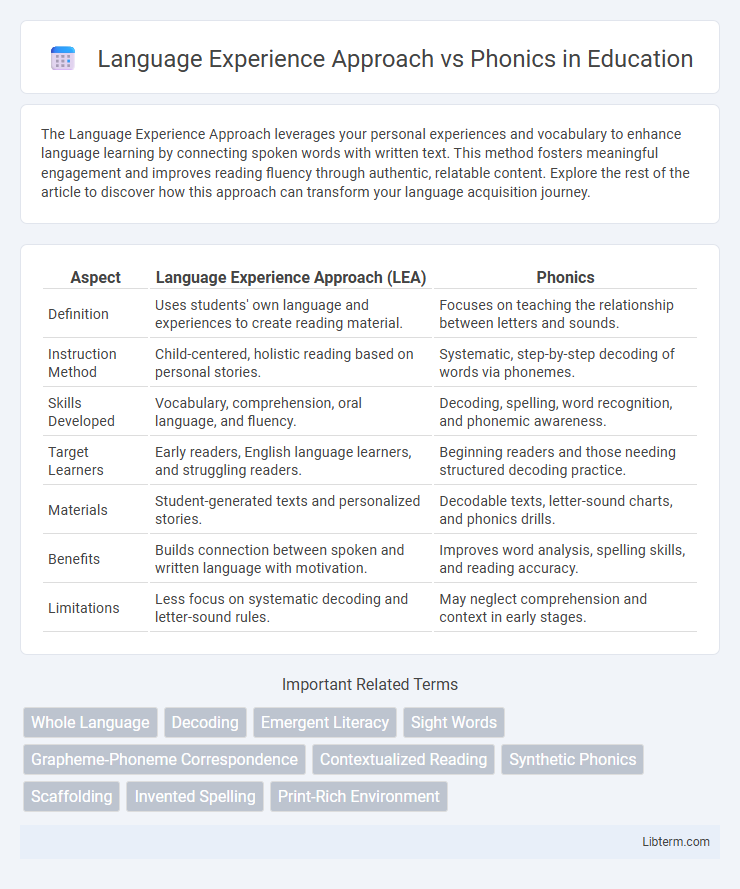The Language Experience Approach leverages your personal experiences and vocabulary to enhance language learning by connecting spoken words with written text. This method fosters meaningful engagement and improves reading fluency through authentic, relatable content. Explore the rest of the article to discover how this approach can transform your language acquisition journey.
Table of Comparison
| Aspect | Language Experience Approach (LEA) | Phonics |
|---|---|---|
| Definition | Uses students' own language and experiences to create reading material. | Focuses on teaching the relationship between letters and sounds. |
| Instruction Method | Child-centered, holistic reading based on personal stories. | Systematic, step-by-step decoding of words via phonemes. |
| Skills Developed | Vocabulary, comprehension, oral language, and fluency. | Decoding, spelling, word recognition, and phonemic awareness. |
| Target Learners | Early readers, English language learners, and struggling readers. | Beginning readers and those needing structured decoding practice. |
| Materials | Student-generated texts and personalized stories. | Decodable texts, letter-sound charts, and phonics drills. |
| Benefits | Builds connection between spoken and written language with motivation. | Improves word analysis, spelling skills, and reading accuracy. |
| Limitations | Less focus on systematic decoding and letter-sound rules. | May neglect comprehension and context in early stages. |
Introduction to Language Experience Approach (LEA) and Phonics
The Language Experience Approach (LEA) introduces reading through personalized stories drawn from learners' own language and experiences, promoting comprehension and language development by connecting speaking, listening, and writing. Phonics emphasizes the relationship between letters and sounds, teaching decoding skills by systematically helping learners understand sound-symbol correspondences for effective reading. Both methods support literacy acquisition, with LEA fostering contextual understanding and phonics focusing on foundational decoding techniques.
Core Principles of Language Experience Approach
The Core Principles of the Language Experience Approach emphasize learner-generated text, where students dictate stories or experiences that teachers transcribe, promoting meaningful, contextualized reading and writing. This approach integrates oral language with literacy development, supporting comprehension and vocabulary through personal relevance and shared language experiences. Unlike phonics, which focuses on decoding and systematic sound-letter relationships, the Language Experience Approach centers on holistic language use and emergent literacy skills.
Key Concepts of Phonics Instruction
Phonics instruction centers on teaching the systematic relationship between letters and sounds to develop decoding skills essential for reading fluency. Key concepts include phonemic awareness, letter-sound correspondence, blending, and segmenting phonemes to decode unfamiliar words. Unlike the Language Experience Approach, which relies on personal language and contextual cues, phonics emphasizes explicit, structured teaching of sound-letter patterns for accurate word recognition.
Differences in Teaching Methods
The Language Experience Approach centers on using a student's own spoken language to create reading materials, promoting personalized learning and immediate relevance. Phonics instruction systematically teaches the relationship between letters and sounds through explicit decoding rules and repetitive practice. While the Language Experience Approach emphasizes contextual and holistic learning, phonics relies on structured, sequential skill development to build reading proficiency.
Benefits of the Language Experience Approach
The Language Experience Approach (LEA) leverages a learner's personal language and experiences to build reading and writing skills, fostering strong connections between spoken and written words. This method supports individualized learning by allowing students to create texts based on their own stories, which enhances motivation, comprehension, and vocabulary development. LEA also encourages active participation and cultural relevance, making literacy instruction more meaningful and accessible for diverse learners.
Advantages of Phonics Instruction
Phonics instruction provides systematic and explicit teaching of letter-sound relationships, which enhances decoding skills essential for reading development. This approach supports early literacy by enabling learners to independently decipher new words and improve spelling accuracy. Research shows phonics instruction leads to higher reading fluency and comprehension compared to methods lacking structured phonemic awareness training.
Challenges and Limitations of LEA
The Language Experience Approach (LEA) faces challenges such as limited scalability for large classrooms and difficulty addressing the systematic instruction of phonics, which is crucial for decoding unfamiliar words. LEA heavily relies on students' oral language skills and might not provide sufficient focus on phonemic awareness or explicit letter-sound relationships. These limitations can hinder the development of independent reading skills compared to the structured, sequential teaching found in phonics-based methods.
Potential Drawbacks of Phonics-Based Learning
Phonics-based learning may lead to difficulties in recognizing irregular word patterns and hinder the development of natural language comprehension skills. This approach often emphasizes decoding over contextual understanding, which can limit students' ability to grasp meaning from text. Relying heavily on phonics might result in reduced motivation and engagement for learners who benefit from more interactive, meaningful language experiences.
When to Use LEA vs Phonics in the Classroom
The Language Experience Approach (LEA) is most effective for early emergent readers or ELL students who benefit from using their own spoken language to develop reading skills, promoting engagement through personal storytelling and contextual vocabulary. Phonics instruction is ideal when students have foundational oral language skills and need systematic teaching of letter-sound relationships to decode and encode words independently. Educators should use LEA when aiming to build comprehension and confidence in reading through familiar language, while phonics is better suited for explicit decoding practice during structured literacy lessons.
Integrating LEA and Phonics for Balanced Literacy
Integrating the Language Experience Approach (LEA) with phonics instruction enhances balanced literacy by combining meaningful, context-rich reading experiences with systematic phonemic awareness development. LEA leverages personal narratives to build vocabulary and comprehension, while phonics provides explicit decoding skills essential for word recognition. This synergy fosters both fluency and linguistic confidence, supporting diverse learners in acquiring proficient reading abilities.
Language Experience Approach Infographic

 libterm.com
libterm.com